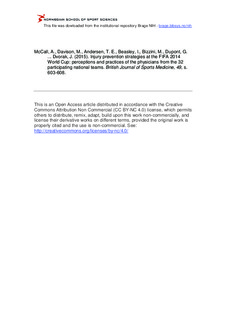| dc.contributor.author | McCall, Alan | |
| dc.contributor.author | Davison, Michael | |
| dc.contributor.author | Andersen, Thor Einar | |
| dc.contributor.author | Beasley, Ian | |
| dc.contributor.author | Bizzini, Mario | |
| dc.contributor.author | Dupont, Gregory | |
| dc.contributor.author | Duffield, Rob | |
| dc.contributor.author | Carling, Chris | |
| dc.contributor.author | Dvorak, Jiri | |
| dc.date.accessioned | 2015-08-05T11:27:14Z | |
| dc.date.available | 2015-08-05T11:27:14Z | |
| dc.date.issued | 2015 | |
| dc.identifier.citation | British Journal of Sports Medicine. 2015, 49, 603-608 | nb_NO |
| dc.identifier.uri | http://hdl.handle.net/11250/294826 | |
| dc.description | This is an Open Access article distributed in accordance with the Creative Commons Attribution Non Commercial (CC BY-NC 4.0) license, which permits others to distribute, remix, adapt, build upon this work non-commercially, and license their derivative works on different terms, provided the original work is properly cited and the use is non-commercial. See: http://creativecommons.org/licenses/by-nc/4.0/ | nb_NO |
| dc.description.abstract | Purpose: The available scientific research regarding injury prevention practices in international football is sparse. The purpose of this study was to quantify current practice with regard to (1) injury prevention of top-level footballers competing in an international tournament, and (2) determine the main challenges and issues faced by practitioners in these national teams.
Methods: A survey was administered to physicians of the 32 competing national teams at the FIFA 2014 World Cup. The survey included 4 sections regarding perceptions and practices concerning non-contact injuries: (1) risk factors, (2) screening tests and monitoring tools, (3) preventative strategies and (4) reflection on their experience at the World Cup.
Results: Following responses from all teams (100%), the present study revealed the most important intrinsic (previous injury, accumulated fatigue, agonist:antagonist muscle imbalance) and extrinsic (reduced recovery time, training load prior to and during World Cup, congested fixtures) risk factors during the FIFA 2014 World Cup. The 5 most commonly used tests for risk factors were: flexibility, fitness, joint mobility, balance and strength; monitoring tools commonly used were: medical screen, minutes/matches played, subjective and objective wellness, heart rate and biochemical markers. The 5 most important preventative exercises were: flexibility, core, combined contractions, balance and eccentric.
Conclusions: The present study showed that many of the National football (soccer) teams’ injury prevention perceptions and practices follow a coherent approach. There remains, however, a lack of consistent research findings to support some of these perceptions and practices. | nb_NO |
| dc.language.iso | eng | nb_NO |
| dc.publisher | BMJ Publishing Group | nb_NO |
| dc.title | Injury prevention strategies at the FIFA 2014 World Cup: perceptions and practices of the physicians from the 32 participating national teams | nb_NO |
| dc.type | Journal article | nb_NO |
| dc.type | Peer reviewed | nb_NO |
| dc.subject.nsi | VDP::Social science: 200::Social science in sports: 330::Other subjects within physical education: 339 | nb_NO |
| dc.source.journal | British Journal of Sports Medicine | nb_NO |
| dc.description.localcode | Seksjon for idretssmedisinske fag / Department of Sports Medicine | nb_NO |
